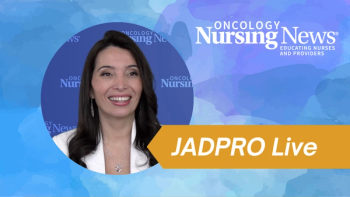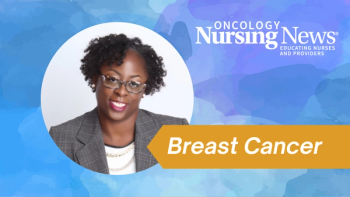
Voices Behind the Mask: Oncology Nurses Speak Out About Their COVID-19 Experiences
Seasoned oncology nurses share how the COVID-19 pandemic has affected the standard of care at their institution, the consequences of the staffing shortage, and how they believe the oncology community can work together to create a better working environment.
The rise of the COVID-19 pandemic has dramatically increased staffing shortages and burnout among nursing professionals.
In an interview with Oncology Nursing News®, 3 experienced oncology nurses share their experiences working throughout the pandemic—particularly in light of the recent Omicron surge. The oncology nurses explain how their institutions have responded to the various crises, how staffing shortages have affected with the quality of care that patients receive and how, in their opinion, hospital administrators can work with nurses to create a more effective care delivery model moving forward.
Out of respect for the nurses’ privacy and their wishes, Oncology Nursing News® has agreed to omit their names and institutions from the interview.
Oncology Nursing News®: How long have you been working in health care?
Nurse 1:I have been an oncology nurse for 25 years, since 1997.
Nurse 2: I have been working in health care for 30 years.
Nurse 3: 12.5 years.
What subspecialty of nursing do you currently work in?
Nurse 1: I am an oncology nurse, with specialization in hematologic malignancies and advanced cancers. I have a clinical practice in the care of adults with these cancers. I also am a full-time faculty member and researcher at a prominent school of nursing and cancer center.
Nurse 2: I am an oncology nurse.
Nurse 3: I work in oncology, in a bone marrow transplant (BMT)/chimeric antigen receptor therapy (CAR-T) outpatient setting.
How has your institution responded to the omicron surge?
Nurse 1: I am not authorized to speak on specific policies at my University, however; what I am seeing and hearing is tremendous strain in our cancer centers across the country, both in inpatient and outpatient settings. The surge of COVID-19 cases has flooded inpatient settings, so patients have to wait longer for beds, tests, and inpatient treatments. Another impact is that, due to space constraints, patients with cancer may be admitted to non-oncology floors, so they are not benefiting from the specialized care that oncology nurses offer.
In the outpatient setting, clinics need to maintain physical distancing, so fewer infusion and treatment spaces are open. Shortages of nurses, phlebotomists, radiology, and pharmacy personnel, among others, translates to longer wait times for patients and the need to reschedule patients.
Many cancer centers have shifted to virtual visits for clinically stable patients who may not need a physical exam. Centers have also tried to redistribute patients to other settings within their system to reduce the pressure. Some centers are also rapidly launching home infusion services for certain patients who meet certain criteria.
As the staffing shortages persist or worsen, cancer centers are facing the tough decision of triaging treatment times for patients. This is very unsettling, as we want to deliver care to all patients we serve. Yet, it may not be possible to do so and some centers are drafting guidance principles for prioritizing appointments for cancer treatment.
I have observed that several local hospice services are not accepting new patients. This places a huge burden on the cancer care team to deliver exceptional end-of-life care to patients in a setting of reduced inpatient capacity and suboptimal options to manage patients outside of the inpatient setting.
Nurse 2: My institution has responded by pausing elective procedures, restricting the number of permitted visitors for inpatients (only 2 caregivers are allowed to visit hospice care), not allowing caregivers in infusion suites—except for in extenuating circumstances, allowing only 1 support person to attend in-person office visits.
In addition, since the pandemic began, we require all visitors and staff to wear masks. We require all employees to be vaccinated as a condition of employment.
Nurse 3: They have tried their best to increase both proactive and reactive testing for associates, but it has sometimes been difficult to schedule because you may have to wait on the phone with occupational health for over an hour.
Furthermore, it’s been difficult for people who have tested as positive outside the hospital at other clinics to report this to occupational health as follow-up. This places stress on management as well because many associates want to report positive tests only to their managers, who are not equipped to provide follow-up advice and clearance to return to work. The initial 2 weeks of the surge were extremely stressful on staff and resulted in increased staffing shortages for several weeks.
How has your institution responded to the staffing shortage?
Nurse 1: Cancer centers are facing the harsh reality of having to operate with fewer personnel. In some cases, appointments need to be rescheduled or relocated, which is inconvenient to patients and families.
Nurse 2: In the inpatient setting, up to $10,000 sign-on bonuses have been offered for some open positions, travel nurses have been hired; MAs, CNAs, and student nurses in their junior/senior year have been hired to help the inpatient surge. Additionally, some registered nurses in non-clinical roles have been required to return to bedside roles in some capacity.
Nurse 3: By increasing the rate at which they are offering travel nurses—sometimes up to $200/hour. There are also some efforts to make more positions flexible. For example, my institution currently allows more part-time positions as well as flexible sets of four 10-hour shifts, instead of a mandatory Monday through Friday. There are also some instances of remote working part-time options for positions that require a lot of patient coordination and patient triage outpatient. For example, example for nurse navigators or BMT coordinators.
I think this is critical to help the profession attract and attain nurses in the market looking for more flexible working hours due to family or more work/life balance overall. If institutions are able to do this, along with provide strong salaries and solid benefits (especially time off for vacation and sick leave) then I think staffing shortages will alleviate.
How has essential care been compromised by the lack of available nurses?
Nurse 1: The field is in a perilous time. We are challenged with trying to deliver the very best care to patients and families, while we have staffing and resource constraints. That means less time for patient and family education, and [there is a lower] ability to monitor and act on treatment side effects.
Prior work on missed oncology nursing care has shown that care coordination with the cancer team is the second most frequent missed care item. In the current crisis, it's likely that coordinating care for patients and assuring safe discharges to home or other settings are more difficult. Visitor restrictions place an additional burden on patients and families as fewer loved ones can be by the patient's side during treatment. What we know from the literature is that when staffing levels are low, patients are less likely to receive needed ambulation, mouth care, assistance with toileting, and delayed medication administration.
Nurse 3: Sometimes you have one nurse doing the role of 4 or 5 positions, especially in the outpatient setting. This means there are less patient education opportunities, providers (physicians, NP’s, etc.) are frustrated with slow patient coordination, and management is unhappy with slow growth of a program. Moreover, the staff that remains is burnt out. For patients waiting for a BMT, the timing of transplant is key to prevent relapse of disease. With no/low staff to coordinate, patients have to wait longer for essential services, such as transplant and CAR-T therapy.
How have the longer shifts negatively impacted both patients and employees in your institution?
Nurse 1: As we see more staff vacancies, either due to turnover or COVID-19 exposure, management is often asking nurses to stay longer or pick up more shifts. We know that extra-long shifts are associated with higher likelihood of patient safety events and that additional overtime shifts contribute to higher levels of burnout. We need to be careful to spread this extra burden around equitably.
This pandemic has taught us that crisis may not resolve swiftly. It's okay for a nurse to decline to stay late or accept another shift to attend to their own needs and wellness. Nurses' mental health is really important to monitor and address right now.
Nurse 2: Although the nurse-to-patient ratios have not changed, the ability to fill these ratios consistently has led to a higher patient load. Patients with cancer are extremely empathetic and understanding and see how hard the nurses are working and are hesitant to ask for anything! Nurses are exhausted and leave work feeling guilty for not doing more, but they’ve given all that they have. Experienced nurses have left the inpatient setting for non-clinical roles, positions in ambulatory care, or have retired completely, leaving a gap of knowledge that will not be able to be replaced.
Nurse 3: [There is]definitely burnout and sometimes caregiver fatigue. You see staff leaving the hospital unhappy. When they reach home, they are too tired to spend quality time with their family and/or do important things such as exercise or cook healthy meals. I’m really worried about the overall physical and mental health of healthcare workers, especially those who are covering multiple positions.
In your opinion, what is the best way to alleviate the burden that is currently being placed upon nursing professionals?
Nurse 1: I challenge nurse leaders to critically examine the practice environments for oncology nurses: Have you down all that you can to reduce administrative burdens so that nurses have the majority of their time devoted to patient care? Have you streamlined documentation and other administrative tasks to the bare, required minimum? Have you engaged your nursing team in a discussion about how they want to practice?
If we don't attend to these critical items, I fear the staff shortages we are experiencing now will only worsen. We can't wait to resolve this when the pandemic eases nor can we assume that things will return to normal. Now is the time for oncology nurses and their leaders to envision and enact a better care delivery model that serves patients, families, and clinicians.
Nurse 2: One way is to allow more flexible schedules for all staff in regard to time; help is needed around the clock. If someone can work 3 am until 7 am, or noon until 5pm, let them!
Allow job sharing of all roles, rather than posting for permanent full-time—ask the staff what they want and what could help them and do it! Some experienced nurses who have resigned or retired would have liked to continue to work 1 or 2 days a week or part-time, work in a float position, or with telehealth visits, but they weren't allowed!
Administrators should reconsider allowing fully vaccinated/masked caregivers in the infusion centers. Family members are usually waiting in their cars in the parking lot so that they are close by, so why not let them come inside and get a blanket for their loved one, or get them a glass of water and therefore allow the nurses to monitor patients and triage calls?
Lastly, partner experienced nurses with novice nurses, we can learn a lot from each other. Revisit team nursing rather than primary nursing. Hire LPNs and ADNs. Pause accreditation visits.
Nurse 3: Employers need to do all they can to attract and attain staff. Listen to their concerns and act. Have impressive paid time off practices where employees can catch up on work life balance and feel they are valued for the extra hours they put in working. Also, employers need to pay well or other institutions will offer bonuses and better salaries and their employees will leave.


















































































